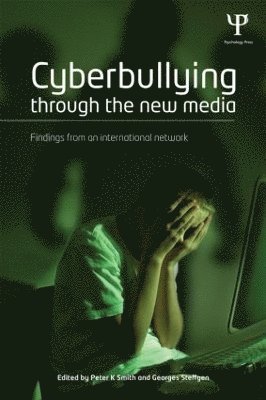
- Format
- Häftad (Paperback / softback)
- Språk
- Engelska
- Antal sidor
- 320
- Utgivningsdatum
- 2013-11-11
- Förlag
- Psychology Press Ltd
- Medarbetare
- Steffgen, Georges
- Illustrationer
- 24 Tables, black and white; 6 Line drawings, black and white; 6 Illustrations, black and white
- Dimensioner
- 234 x 156 x 17 mm
- Vikt
- Antal komponenter
- 1
- Komponenter
- 49:B&W 6.14 x 9.21 in or 234 x 156 mm (Royal 8vo) Perfect Bound on White w/Gloss Lam
- ISBN
- 9781848722545
- 449 g
Cyberbullying through the New Media
Findings from an international network
- Skickas från oss inom 7-10 vardagar.
- Fri frakt över 249 kr för privatkunder i Sverige.
Passar bra ihop
De som köpt den här boken har ofta också köpt The Anxious Generation av Jonathan Haidt (inbunden).
Köp båda 2 för 1245 krKundrecensioner
Fler böcker av författarna
-
Kvantmedvetandet : en resa genom verkligheter
Peter Smith
-
Bullying in Schulen
Yan Huberty, Georges Steffgen
-
Mobbing an Schulen
Matthias Bhmer, Georges Steffgen
-
Rassismus an Schulen
Matthias Bhmer, Georges Steffgen
Övrig information
Peter K. Smith is Emeritus Professor of Psychology at the Unit for School and Family Studies at Goldsmiths College, University of London. He chaired COST Action IS0801 on Cyberbullying (2008-2012), and is currently PI of a European-Indian Network project on bullying, cyberbullying, and school safety and wellbeing (2012-2015). His research interests are in social development, school bullying, play and grandparenting. Georges Steffgen is a professor at the University of Luxembourg. He directs a research group on aggression especially violence in school and cyberbullying as well as approaches to health promotion. He has been project manager of national and international scientific projects on violence in school and anger. He authored and co-authored more than 40 papers in international journals and books, and he is editor or co-editor of 14 books. He co-chaired COST Action IS0801 on Cyberbullying.
Innehållsförteckning
Preface. Introduction. 1. Peter K Smith, Georges Steffgen, Ruth Sittichai, The nature of cyberbullying, and an international network. Definition and Measurement. 2. Ersilia Menesini, Annalaura Nocentini, Benedetta Emanuela Palladino, Herbert Scheithauer, Anja Schultze-Krumbholz, Ann Frisn, Sofia Berne, Piret Luik, Karin Naruskov, Rosario Ortega, Juan Calmaestra, Catherine Blaya, Definitions of cyberbullying. 3. Ann Frisn, Sofia Berne, Anja Schultze-Krumbholz, Herbert Scheithauer, Karin Naruskov, Piret Luik, Catarina Katzer, Rasa Erentaite, Rita Zukauskiene, Measurement issues: A systematic review of cyberbullying instruments. Regulation and the media. 4. Marilyn Campbell, Ales Zavrsnik, Should cyberbullying be criminalized? 5. Iain Coyne, Vasiliki Gountsidou, The role of the industry in reducing cyberbullying. 6. Heidi Vandebosch, Roma Simulioniene, Magdalena Marczak, Anne Vermeulen, Luigi Bonetti, The role of the media. Coping and guidelines. 7. Conor Mc Guckin, Sonja Perren, Lucie Corcoran, Helen Cowie, Francine Dehue, Anna evkov, Panayiota Tsatsou, Trijntje Vllink. Coping with cyberbullying: How can we prevent cyberbullying and how victims can cope with it. 8. Mona OMoore, Donna Cross, Maritta Valimaki, Ana Almeida, Sofia Berne, Marjo Kurki, Dorit Olenik-Shemesh, Tali Heiman, Gie Deboutte, Hildegunn Fandrem, Gitte Stald, Efi Sygkollitou, Marta Fulop, Guidelines to prevent cyber-bullying: A cross-national review. Research challenges. 9. Helen Cowie, Sheri Bauman, Iain Coyne, Carrie Myers, Maili Prhl, Ana Almeida, Cyberbullying amongst university students: an emergent cause for concern? 10. Barbara Spears, Angela Costabile, Antonella Brighi, Rosario Del Rey, Maila Prhl, Virginia Sanchez, Christiane Spiel, Fran Thompson, Positive uses of new technologies, in relationships in educational settings. 11. Barbara Spears, Jette Kofoed, Transgressing research binaries: Youth as knowledge brokers in cyberbullying research. 12. Donna Cross, Marilyn Campbell, Phillip Slee, Barbara Spears, Amy Barnes, Australian research to encourage school students positive use of technology to reduce cyberbullying. 13. Vera Boronenko, Zehra Ucanok, Phillip Slee, Marilyn Campbell, Donna Cross, Maritta Valimaki, Barbara Spears, Training researchers: visits and training schools. Commentaries. 14. Justin W. Patchin, Sameer Hinduja, Cyberbullying Research: standing on the shoulders of international giants. 15. Anders Eklund, Susan Flocken, Practitioner commentary from ETUCE. 16. Keith Sullivan, Addressing cyberbullying through more effectively bridging research and practice. Index
Du kanske gillar
-
Atomic Habits
James Clear
Häftad


